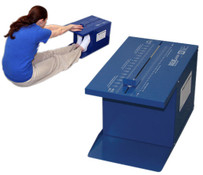The ability to accurately measure flexibility of muscles/soft tissue and the range of motion allowed at a joint are important in the assessment of fitness and pathology affecting joint movement. Range of motion (ROM) testing devices and tools come in different configurations depending on the joint(s) ROM to be measured. These include goniometers, inclinometers, and sit-and-reach boxes. Check out the flexibility and range of motion testing devices available from ProHealthcareProducts.com.
5% off Your Entire Purchase of $300 or More - Use Code TAKE5 During Checkout 

Categories
- Activities of Daily Living
- Ambulation Training Equipment
- Aquatic Therapy
- Balance Training Equipment
- Bathroom Assists
- Beds, Mattresses & Accessories
- Cardiorespiratory Exercise Equipment
- Chiropractic Equipment
- Diabetic Care
- Exercise Equipment
- Fitness Agility
- Flexibility & Stretching Equipment
- Flexibility and ROM Testing Devices
- Gait Assists
- Hand Therapy
- Home Care
- Hot and Cold Therapy
- Human Anatomical Charts
-
Human Anatomy Models
- Human Arm Models
- Human Bones Models
- Human Brain Models
- Human Ear Models
- Human Eye Models
- Human Foot Models
- Human Full Body Skeleton Models
- Human Hand Models
- Human Heart Models
- Human Joints Models
- Human Larynx Models
- Human Leg Models
- Human Muscle Models
- Human Pelvis Models
- Human Skull Models
- Human Spine Models
- JTech Medical Products
- Massage
- Medical Clinic Supplies
- Medical Equipment & Supplies
-
Medical Diagnostics
- Aesthesiometers
- Biofeedback
- Percussion/ Reflex Hammers
- Physical Therapy Student Kit
- Anthropometric Tools
- Body Fat Measurement
- Cognitive Testing
- Electronic BP and Pulse Monitors
- Evaluation Sets
- Fingertip Pulse Oximeters
- Medical Thermometers
- Monofilament Tests
- Ophthalmoscopes & Otoscopes
- Sensory Evaluation
- Sphygmomanometers /Blood Pressure Gauges
- Spirometers
- Stethoscope
- Time & Distance
- Weight Scales
- Medical Scooters
- Medical Simulators
- Muscle Strength Testing Devices
- Occupational Therapy Equipment
- Pediatric Therapy
- Phlebotomy Equipment
- Physical Therapy Products
- PPE
- Resistance Training Devices
- Resistance Training Exercise Equipment
- Resistance Training Weights
- Respiratory/Oxygen Aids
- Skillbuilders Therapy Products
- Splints, Braces, Wraps, Supports & Scissors
- Sports Medicine Equipment
-
Therapeutic Modalities
- Acupuncture Needles
- AED
- Combo Ultrasound and E-Stim Therapy
- Compression Therapy
- Continuous Passive Motion (CPM) Devices
- Dry Needling
- Electrotherapy Accessories
- Electrotherapy Devices
- IASTM
- Iontophoresis
- Light and Laser Therapy Machines
- Neuromuscular Electrical Stimulation (NMES / EMS)
- Shockwave Therapy
- Shortwave Diathermy
- TENS Units
- Ultrasound Therapy Machines
- Treatment Furniture
- Transportation Equipment - Emergency
- Treatment Tables
- Wheelchairs
- Whirlpool Therapy Tubs
- Work Hardening Products
- Parts and Accessories
Quick Links
- Starting a Clinic
- Contact us
- About Us
- Resources
- Blog
- Request a Quote






